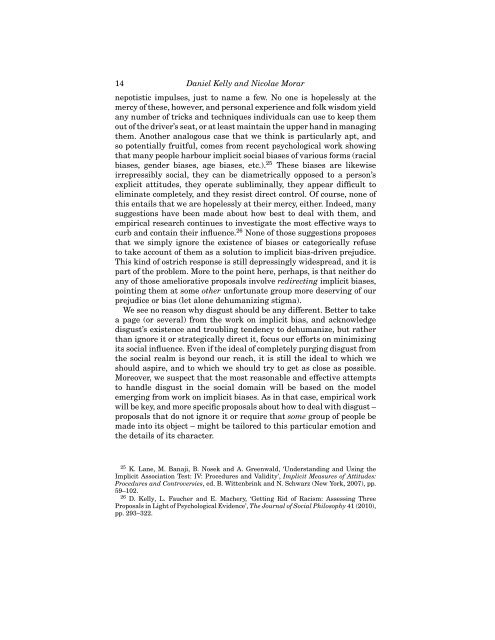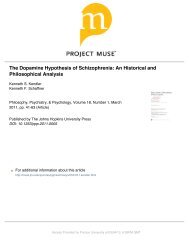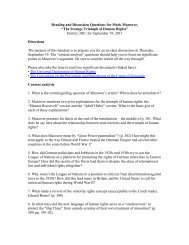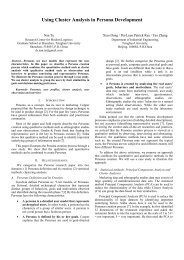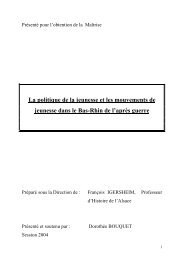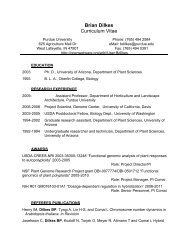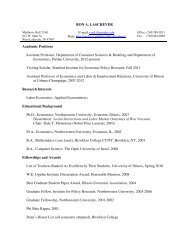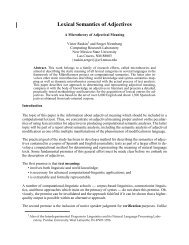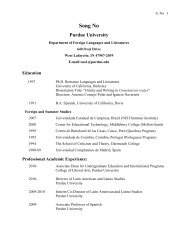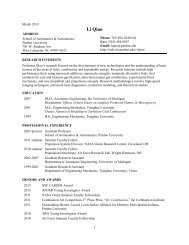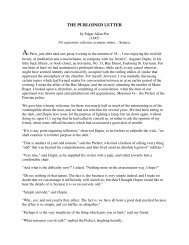Against the Yuck Factor - Career Account Web Pages - Purdue ...
Against the Yuck Factor - Career Account Web Pages - Purdue ...
Against the Yuck Factor - Career Account Web Pages - Purdue ...
Create successful ePaper yourself
Turn your PDF publications into a flip-book with our unique Google optimized e-Paper software.
14 Daniel Kelly and Nicolae Morar<br />
nepotistic impulses, just to name a few. No one is hopelessly at <strong>the</strong><br />
mercy of <strong>the</strong>se, however, and personal experience and folk wisdom yield<br />
any number of tricks and techniques individuals can use to keep <strong>the</strong>m<br />
out of <strong>the</strong> driver’s seat, or at least maintain <strong>the</strong> upper hand in managing<br />
<strong>the</strong>m. Ano<strong>the</strong>r analogous case that we think is particularly apt, and<br />
so potentially fruitful, comes from recent psychological work showing<br />
that many people harbour implicit social biases of various forms (racial<br />
biases, gender biases, age biases, etc.). 25 These biases are likewise<br />
irrepressibly social, <strong>the</strong>y can be diametrically opposed to a person’s<br />
explicit attitudes, <strong>the</strong>y operate subliminally, <strong>the</strong>y appear difficult to<br />
eliminate completely, and <strong>the</strong>y resist direct control. Of course, none of<br />
this entails that we are hopelessly at <strong>the</strong>ir mercy, ei<strong>the</strong>r. Indeed, many<br />
suggestions have been made about how best to deal with <strong>the</strong>m, and<br />
empirical research continues to investigate <strong>the</strong> most effective ways to<br />
curb and contain <strong>the</strong>ir influence. 26 None of those suggestions proposes<br />
that we simply ignore <strong>the</strong> existence of biases or categorically refuse<br />
to take account of <strong>the</strong>m as a solution to implicit bias-driven prejudice.<br />
This kind of ostrich response is still depressingly widespread, and it is<br />
part of <strong>the</strong> problem. More to <strong>the</strong> point here, perhaps, is that nei<strong>the</strong>r do<br />
any of those ameliorative proposals involve redirecting implicit biases,<br />
pointing <strong>the</strong>m at some o<strong>the</strong>r unfortunate group more deserving of our<br />
prejudice or bias (let alone dehumanizing stigma).<br />
We see no reason why disgust should be any different. Better to take<br />
apage(orseveral)from<strong>the</strong>workonimplicitbias,andacknowledge<br />
disgust’s existence and troubling tendency to dehumanize, but ra<strong>the</strong>r<br />
than ignore it or strategically direct it, focus our efforts on minimizing<br />
its social influence. Even if <strong>the</strong> ideal of completely purging disgust from<br />
<strong>the</strong> social realm is beyond our reach, it is still <strong>the</strong> ideal to which we<br />
should aspire, and to which we should try to get as close as possible.<br />
Moreover, we suspect that <strong>the</strong> most reasonable and effective attempts<br />
to handle disgust in <strong>the</strong> social domain will be based on <strong>the</strong> model<br />
emerging from work on implicit biases. As in that case, empirical work<br />
will be key, and more specific proposals about how to deal with disgust –<br />
proposals that do not ignore it or require that some group of people be<br />
made into its object – might be tailored to this particular emotion and<br />
<strong>the</strong> details of its character.<br />
25 K. Lane, M. Banaji, B. Nosek and A. Greenwald, ‘Understanding and Using <strong>the</strong><br />
Implicit Association Test: IV: Procedures and Validity’, Implicit Measures of Attitudes:<br />
Procedures and Controversies, ed.B.WittenbrinkandN.Schwarz(NewYork,2007),pp.<br />
59–102.<br />
26 D. Kelly, L. Faucher and E. Machery, ‘Getting Rid of Racism: Assessing Three<br />
Proposals in Light of Psychological Evidence’, The Journal of Social Philosophy 41 (2010),<br />
pp. 293–322.


